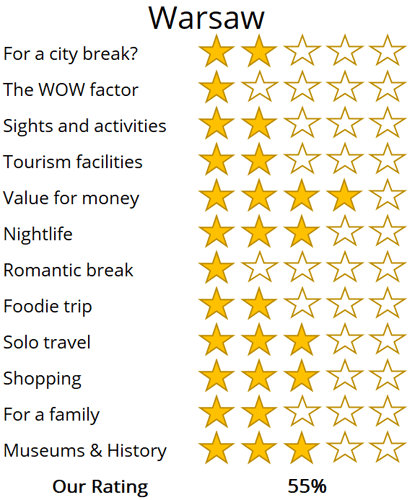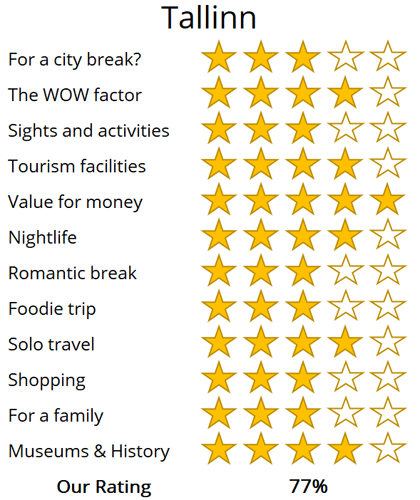WhereToGoForMyHoliday.com
The best destination comparison site!
WhereToGoForMyHoliday.com
The best destination comparison site!
Warsaw or Tallinn a vs city comparison and travel guide
Warsaw and Tallinn both offer unique and enticing experiences, but which one should you choose for your city break or holiday?
We understand your dilemma. There is an abundance of travel guides for both cities, but few actually comparing them, and advising you which is the better for your trip.
This article will provide our unbiased and independent views of Tallinn and Warsaw, hopefully making your choice that little easier.
The article is structured into several sections, each of which can be directly accessed through the following links:
• Introduction to the cities
• Scores and ratings
• Which one should I, friends, or family visit?
• When to visit and weather
• Who is the city suited for?
• The perfect 48hours (with map)
• Tourism details (where to stay? airport details?)
Introduction to Warsaw and Tallinn
Warsaw is a vibrant city that seamlessly blends the old with the new, offering a mix of historical sites and modern attractions.
This Polish capital is a city of contrasts. On one hand, you have futuristic shopping centres, and on the other, a Soviet-era skyscraper dominating the skyline. The Old Town, with its medieval appearance, is actually a meticulous reconstruction post-World War II.
It's this variety that makes Warsaw so intriguing. Whether you’re taking a romantic stroll through Łazienki Park, learning about the anti-Nazi uprisings, admiring Polish art in national galleries, or exploring the trendy Mokotow district, there’s always something new to discover.
You could be forgiven for thinking you'd been plucked from the 21st century and dropped back in the 1300s when you step foot in Old Town Tallinn. Cobblestone lanes braid their way through stooped taverns with drooping roofs, chimney stacks, and grey stone keeps that echo The Lord of the Rings.
Aged Toompea Hill is the anchor of it all, erupting above the capital with its muscular castles and onion-domed churches. Below, the Lower Town buzzes with energy, pitting beer bars next to Baltic eateries and church steeples.
Tallinn has also established itself as one of Europe's most cutting-edge cities in recent years. It's a digital powerhouse with start-ups and creative agencies galore. They fuel areas like Kalamaja, which is all roaster coffee joints in Soviet tenements and funky bars in rundown prisons that spill into the Baltic Sea, proving it's not all about the history in these parts…
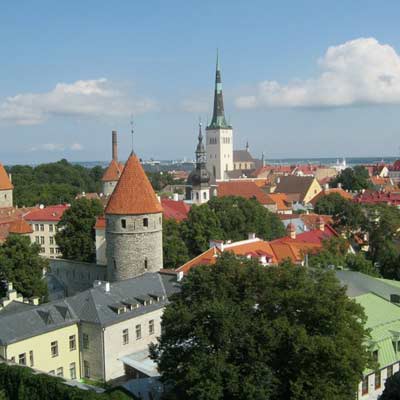
Medieval towers dominate the skyline of central Tallin

The historic centre of Warsaw
Warsaw vs Tallinn: City Ratings
Summary
Where would I journey for a personal escape?
Tallinn
Where would I send my parents for a memorable visit?
Tallinn
Where's the ideal destination for my adventurous 19-year-old cousin?
Tallinn
Where should my food-obsessed friend indulge their culinary passions?
Tallinn
Note: The above comparisons are weather-independent and are based on travel during the most opportune times of the year. Details about the ideal travel seasons are elaborated upon later in this article.
In the sections that follow, you'll find a comprehensive comparison between these two fascinating cities. This includes recommendations on the duration of stay, the best times to visit, and tailored 48-hour itineraries for each city.
The final segment delves into practicalities for your travels, such as the best airport to fly into, the optimal districts for your accommodation, and insider tips, for when you come to explore the city.
We hope that you find all of this information useful, in planning your next exciting trip!
Destination details
How long to spend each city?
Tallinn might not be the biggest European capital, but it's a place that always seems to have another secret up its sleeve. Yes, two days might be enough to see the old city walls, wander Toompea Hill and sample the delights of the Estonian kitchen, but there's certainly enough to fill trips of four, five or even more nights.
Have a think about what you're after from your travels and then decide. If you're eager to squeeze in a few nights on the town (a good shout, as Tallinn is downright hedonistic), daytrips to the wonderful forests and coast swamps of Lahemaa, and a couple of the museums, you'll probably want to give yourself some extra time.
Warsaw can be done quickly. Just a couple days is all you'll need to see the Old Town, the Palace of Culture and Science, the grand parks, and the main museums.
Of course, if you've got extra time to spare, Warsaw will always be able to fill it. Once you've checked off the main attractions, there are stacks of more local sights, eateries, and activities to get stuck into. They include café hopping down in hipster Mokotow, tasting ethnic foods in multicultural Praga, and even day outings to the Kampinos Forest or the post-industrial city of Łódź.
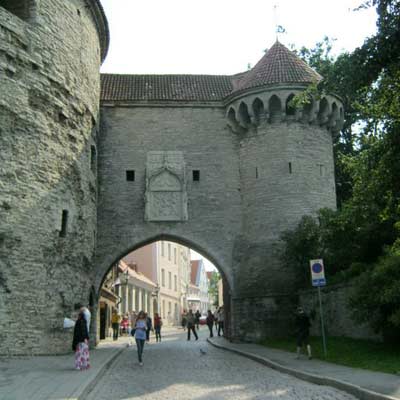
The Suur Rannavärav (Great Coastal Gate) protected Tallinn from seaward invasion

The Park Royal Baths Park (Łazienki Królewskie) is the largest park in Warsaw and a great location for a summers day
The summer is considered to be the finest time in the Tallinn. From around May onwards, the temperature picks up to the high teens and early 20s, there's more sun, and the days are longer. From June onwards, the travellers and the crowds come, lending a buzz to the bars of the Lower Town.
There's no question that Tallinn looks downright gorgeous under plumes of snow in the midwinter. Some say it's the most enchanting time of all, as the nights draw in and there's ice glinting like diamonds on the roofs of the old churches. On the main Town Hall Square, you'll also be able to enjoy the delights of the Tallinn Christmas Market from early December onwards – think handmade Estonian decorations, hot wine, and traditional pastries. Don't expect to be warm, though. The Baltic gets sub-zero and bitter winds all throughout the season.
If you don't want to wrap yourself up in cotton wool and thermals every time you step outside, it might be best to avoid the winter months in Warsaw. From November to December, below-zero temperatures are normal in the Polish capital, along with icy rain, sleet and snow.
Most locals often say that spring and early autumn are the sweet spots. While summer's warm, it can often be humid, and there's no beach or ocean nearby to help you cool off. Months like April and May see milder days and cool nights, while September is prime time to wander the famous parks of Warsaw, as the trees begin to change colour and glow orange, ochre and yellow.
Warsaw captivates those who appreciate lively, bustling capital cities. While the Old Town is stunning, it's not the main attraction. Instead, expect to spend your time exploring vibrant and authentic neighborhoods, filled with a variety of dining options from fusion to fine dining. Discover craft beer on guided tours and enjoy artisan breakfasts in quirky cafes.
On the other hand, Warsaw offers a deeply immersive historical experience. The Warsaw Uprising Museum and the POLIN exhibitions provide insightful introductions to the challenges faced by the Polish people and Polish Jews during Nazi occupation. Don't miss the 800,000 exhibits at the renowned National Museum, and take time to explore grand parks, complete with Chinese gardens and monuments dedicated to Chopin.
If you're keen to go a little off the beaten path and discover somewhere laced with rich history and culture, Tallinn is beckoning. With more and more low-cost flights now serving the local airport, a trip to this north-eastern corner of the continent isn't the chore it once was.
So, anyone eager to ditch the mainstay cities of Western Europe is in luck. Adding to that is an Old Town that's been called the best-preserved medieval quarter in the world, so there's loads for fans of original architecture and atmospheric neighborhoods.
Being so far north means there's nothing like the warmth of the Med or southern Europe up in these reaches of the Baltic. Yes, the summer months can get hot and the sea is only a stone's throw from the city, but Tallinn is hardly a beach destination.
Also remember that this is a small capital by global standards. It's certainly not the pick for anyone on the hunt for a colossal, electrifying metropolis.

The gothic Saint Florian's Cathedral in Warsaw
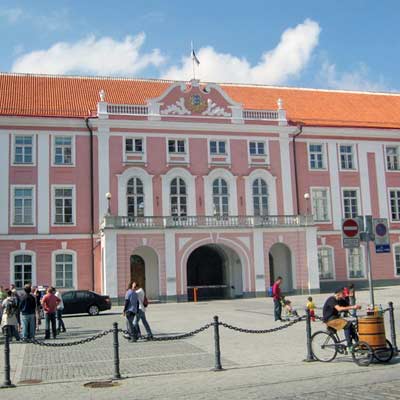
The Baroque wing of the Toompea Castle, is also the parliament building for Estonia
48hours in Tallinn
Wander the Lower Town, see Russian-style cathedrals, taste medieval broths in immersive eateries, gaze at the frothing Baltic waves, duck under ancient fortification walls – all that and more should be a part of any two-day itinerary for the Estonian capital…
Day 1: The Town Hall Square (Raekoja plats) at the very core of the city is always the perfect place to begin. Go there and the sightseeing will start immediately. The eponymous Town Hall itself is the main attraction. It's a beautiful 36-meter structure with a tower that's topped with the Old Thomas weathervane, now a symbol of the city. You're also at the perfect starting point to get lost in the Lower Town of Tallinn.
That's the largest part of the historic center, a UNESCO site, and the place where merchants and guilds would once have plied their trade. Viru Street is one not to miss within. It's a hubbub of shops and eateries, all leading to the handsome Viru Gate, which dates all the way back to the 14th century. A whisker to the north is the Hellemann Tower, offering travellers access to a high lookout point and a 200-metre stretch of the City Walls.
Once you're back on dry ground, delve into the Lower Town once again, going north via Pikk Street. At its end you'll emerge into the hipster area of Kalamaja. Boho coffee shops and Mexican eateries combine there, but the best way to spend the evening is in the block behind Tallinn's train station, where industrial-chic cocktail bars like St. Vitus mix up creative long drinks.
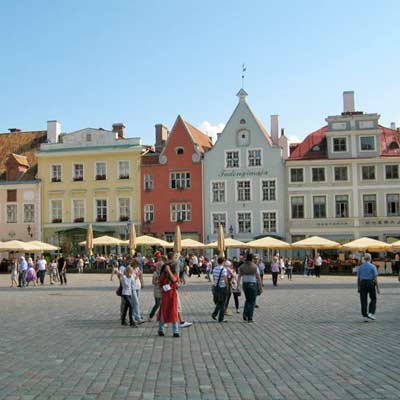
The Raekoja plats plaza is at the heart of Tallinn
Day 2: The early hours see you head above the Lower Town to Toompea Hill. Once the main keep and most fortified part of the historic city, it's still one of the most important postcodes in Estonia. On one side is the soaring Alexander Nevsky Cathedral, sporting onion domes and filigrees that evoke the Russian Empire.
On the other is St Mary's Cathedral, the oldest in the city. This is also the home of the modern Parliament of Estonia. On sunny days, the views across the historic town from Kohtuotsa are some of the best going, taking in the Paks Margareeta tower in the distance and Town Hall Square below.
Descend from Toompea and go back to the centre to find the immersive tavern of III Draakon. A fun-filled character pub, it's got food that mimics the diet of the 1400s and curt service to match. As evening draws in, pinpoint the nightlife hubs of Rataskaevu and Voorimehe for something a little hedonistic!
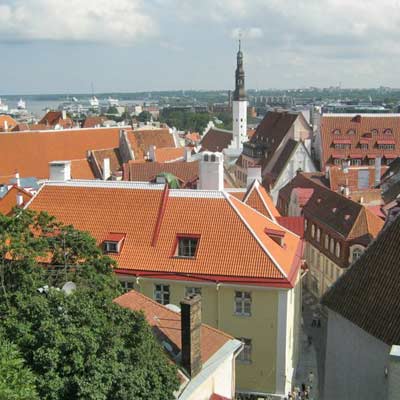
The view over the historic centre of Tallin
48hours in Warsaw
This perfect first 48 hours offers a fun-filled and exciting introduction to life in the Polish capital. It's a cocktail of wartime history, art, and – of course – good old Slavic beer.
Day 1: Hit the Old Town of Warsaw as early as you can. That way, you'll avoid the crowds, and – on a sunny day – get to catch the gilded medieval-style frontispieces in some perfect photography light. You certainly won't want to miss a moment on grand Plac Zamkowy (Castle Square).
The Royal Castle that gives it the name is the star of the show, with its orange-tinged exteriors and Baroque domes. It, like the whole rest of the Old Town, is actually deceptively new. The entire district had to be rebuilt from ruins in the wake of WWII.
Wait for the folk from the Free Walking Tour under Zygmunt's Column. Their two-hour odyssey through this part of the capital really digs down into the unique mosaic of architecture. After that's done, you can hit Nowy Swiat and follow the route Polish monarchs once took in and out of the city. It's now a buzzing modern thoroughfare with dumpling taverns and beer halls (perfect for lunch).
Follow it all the way south and hop a few more blocks and you'll soon be in Łazienki Park. It's an icon of the metropolis. An evening stroll here could start with a vision of the huge Chopin statue and end with a sighting of the Classicist Temple of Diana. For dinner, where better than hipster Mokotow? The district has everything from Tex-Mex to stylish sushi bars.

The Warsaw Barbican (barbakan warszawski) dates from 1540, and was part of the fortifications that encircle the city
Day 2: A selfie stop outside of the iconic Palace of Culture and Science starts day two with a bout of Soviet architecture. A 237-metre spire of a building, it was a personal gift to Poland by one Joseph Stalin. From there, a few trams stops can whisk you over to the Warsaw Uprising Museum. The enthralling exhibits of that showcase the heroic efforts of Poland's underground resistance during the fight against the Nazis.
Afterwards, make straight for the riverside and the leafy Vistula Boulevards. They're a hubbub of life in the summer months. Dog walkers meet buskers and street entertainers right by the water. (An optional drop into the family-friendly Copernicus Science Centre is a great addition if the rain's a-pouring). For the evening, hip and elegant Praga awaits. That's arguably Warsaw's most stylish area, with Lebanese kitchens giving way to bohemian bars and cool coffee shops.

The striking Palace of Culture, standing at 237m is the tallest building in Poland
Public transport in Warsaw means trams and buses. The network of more than 260 combined lines can take you virtually anywhere you want to go.
What's more – it's cheap! Just 3,4 PLN can get you from A to B on any route, but there are also 24- and 72-hour tickets that won't break the bank. You can get them at machines located at the stops, or in any kiosk dotted around town.

Saint Alexander’s Church was constructed in honour of the Russian tsar Alexander I
Warsaw has two international airports. There's the larger Warsaw Frederic Chopin Airport, which can be reached by direct train from Warsaw's main station on line S2 or S3. The smaller Warsaw Modlin International Airport is a hub for European low-cost carriers. To go from terminal to city from there, you can ride the private Modlinbus, or catch the loop train that goes to both airports and then Warszawa Centralna.
A big Polish presence and a welcoming local vibe means there's rarely trouble for tourists in WarsawPickpockets, angry bouncers in clubs, and the classic European taxi scammers are the most common frustrations beyond that. .
When it comes to picking a hotel, it's typically best to be on the western side of the Vistula River. Some of the very best accommodation choices hide amid the cobbled lanes and squares of the Old Town. Others sit within walking distance, by Mirow or the Palace of Culture and Science. Being on the far side of the river means finding some cool aparthotels in local's favourite Praga.
Tallinn Airport is small, but it's served by low-cost carriers coming in from Scandinavia, Russia, and Western Europe. It's only a few miles from the Old Town, and the trip can be done on bus number 2 or with a private taxi – expect to pay in the region of €7-11 for that. Other travellers might come across the Baltic on ferries from Helsinki. They cost about €20 and go several times throughout the day from the port in Finland.
For hotels, the ideal location is the Lower Town. Generally speaking, the closer you get to Town Hall Square, the pricier the establishments become. But you might not even want to be there – it's buzzy and loud. The streets further north and east are laced with other B&Bs and even hostels and are still within walking distance of the monuments. The areas of Tonismagi and Tatari are good alternatives if you're really looking to keep costs low.
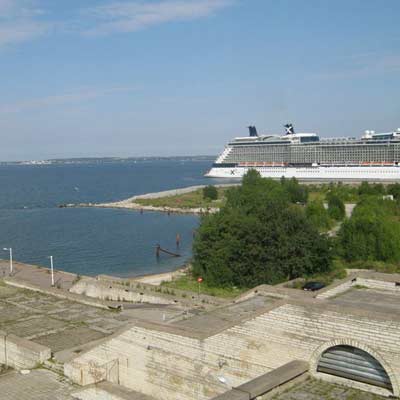
The ferry terminal in Tallinn
Tallinn is a very safe place to travel. It's got low crime rates, and, aside from the ubiquitous pickpockets and taxi scammers, there's rarely any serious issues. Some people have reported extortion scams in nightclubs, but that tends to be limited to the more unsavoury establishments that we think it's best to avoid anyway.
Tallinn is pretty compact and small for a European capital. It's long since burst the seams of its old core, but most of the main sights, bars, pubs, cafés, and museums are still hemmed in by the medieval walls. That means you'll usually be able to walk pretty much anywhere you want. Just be wary of cyclists in the narrow Lower Town streets and icy cobbles in the winter months. Both can be dangers.

oh we were stuck in the airport!

Copenhagen was a bit expensive...

All we did was drink beer in Brussels...

Muncih was crazy

And we got so burnt!

Remeber that night in Rome

oh we were stuck in the airport

So much fun kayaking

Berlin and that group from Austria!

There was such a view from that church

And we got so burnt!

Munich was eventful, wasn't it!

Such a view from that cathedral in Florence

Lisbon was such so much fun

Last summer was so much fun .... x

Remeber that night in Rome

Lisbon was such so much fun

Such a view from that cathedral in Florence

Munich was eventful, wasn't it!

And we got so burnt!

Remeber that night in Rome

All we did was drink beer in Brussels...

Berlin and that group from Austria!

Can't wait to go back to Dubrovnik

Remember that boat ride in Prague

Copenhagen was a bit expensive...
